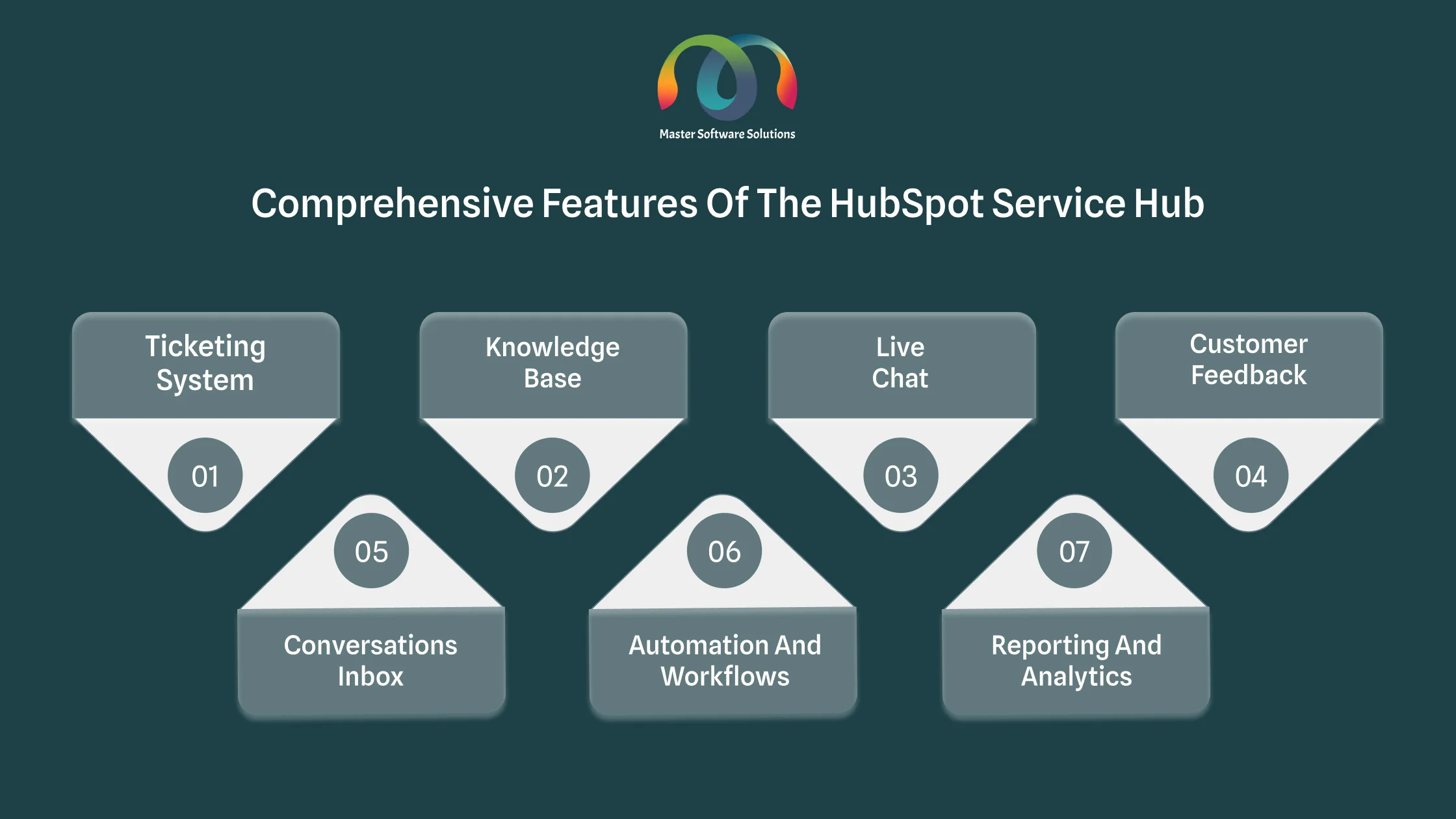Are you looking for a better way to manage your customer service operations?
Do you want to improve your customer’s experiences while streamlining your team’s workflow?
If so, you’ve come to the right place!
This blog will cover various topics, including an overview of the HubSpot service hub, its key features, and how it works with other HubSpot tools. It will also cover real-world use cases, best practices, and how to get the most out of the Service Hub.
What is the HubSpot service hub?
The HubSpot Service Hub is a powerful customer service platform in the HubSpot CRM suite. It provides a comprehensive set of tools and features to assist businesses in managing their customer service operations more effectively, improving customer experiences, and increasing customer loyalty.
The service hub allows you to work seamlessly with the other components of the HubSpot CRM suite, such as the marketing and sales hub, allowing businesses to have a unified view of their customers and deliver a consistent experience across all touchpoints.
What are the challenges a business faces without streamlined customer service management?
A business without a HubSpot service hub may face several challenges:
- Disorganised customer support – Managing customer support and tracking customer inquiries is a challenge and can lead to delays in lead times and poor customer experiences.
- Limited knowledge base – You cannot provide a comprehensive knowledge base, making it hard for customers to find answers to their queries. A lack of a proper knowledge base can increase the workload for your team.
- Inefficient team collaboration – You don’t have a unified communication and collaboration platform, which makes it hard to work together, resulting in duplication of efforts, miscommunications, and delays in issue resolution.
- Lack of data insights – Making rational decisions can be challenging without accurate reports and analytics. It is hard to identify trends and patterns in customer support data.
Manual processes and inefficiencies – Relying on manual processes for manual tasks, like ticket routing and follow-up, leads to inefficiencies and increases the workload of support agents. - Scalability issues – With an increasing support volume and customer base, it is difficult to manage your customer queries.
- Inconsistent customer experiences – It is struggling to provide a consistent customer experience that leads to confusion and frustration, leading to a poor customer experience.
Steps to implement HubSpot service hub into your business
Implementing HubSpot Service Hub entails several steps to ensure it is configured and optimised for your business requirements. Here’s an overview of the implementation process:
- Assessment and planning – Start by evaluating your current customer service procedures and identifying areas for improvement. Determine your goals and objectives for implementing HubSpot Service Hub. Assessment and planning will serve as the foundation for the remaining stages of implementation.
- Account setup – Create a HubSpot account. Set up basic account settings, like company information and user permissions. Purchase a HubSpot service hub subscription to use it.
- Integration – HubSpot Service Hub is compatible with other tools and systems you use, such as CRM, help desk software, and live chat platforms. Set up these integrations so that data flows smoothly between systems.
- Configuration – Customise the HubSpot Service Hub to meet your specific business needs. Defining your business needs includes establishing ticketing workflows, creating knowledge base articles, and configuring your customer support portal.
- Training – HubSpot Service Hub training is critical for teaching your team how to use the platform effectively. Training includes teaching how to use the user interface, manage tickets, create knowledge base articles, and automate tasks.
- Testing and launch – Conduct testing to ensure that the platform meets expectations. Testing includes reviewing ticket workflows and integrations and validating automation rules. Launch the platform and ensure they know the new system.
- Ongoing optimisation – Provide ongoing support to your team as they begin using the HubSpot Service Hub. Continuously monitor and optimise your platform usage based on feedback and changing business requirements.
Comprehensive features of the HubSpot service hub
The service hub allows a seamless workflow along with other components of HubSpot CRM, like the marketing and sales hub. This synchronisation gives a unified view of customers to deliver a consistent experience. The platform aims to improve customer service operations and deliver an exceptional customer experience.
The Service Hub includes several key features, including:
- Ticketing system – You can create and manage support tickets, assign them to specific team members and track their progress with a HubSpot CRM service hub.
- Knowledge base – You can create helpful articles, FAQs, and other resources to help customers find answers without contacting the service team.
- Live chat – Receive messages in real-time to communicate with customers on their website and in other channels.
- Customer feedback – Collect and analyse customer feedback to improve your products and services.
- Conversations inbox – Aggregate customer messages from different channels (e.g., email, chat, social media) to manage and respond to customer inquiries.
- Automation and workflows – Automate your repetitive tasks, such as sending follow-up emails or updating customer records, saving time and improving efficiency.
- Reporting and analytics – Get insights on key metrics like response times, customer satisfaction scores, and ticket volume. Precise insights help to track performance and make data-driven decisions.
Benefits of implementing HubSpot service hub
The HubSpot Service Hub is a robust customer service platform in the HubSpot CRM suite. It offers comprehensive tools and features to help businesses manage customer service operations more effectively, enhance customer experiences, and drive customer loyalty. The HubSpot Service Hub is essential to providing exceptional customer support, improving customer satisfaction, and driving long-term growth and success.
A business needs the HubSpot service hub for several reasons:
- Streamlined customer support – You can centralise all your customer support activities, from ticketing and live chat to knowledge base management and customer feedback. Centralised operations ensure that all customer queries get answered.
- Improved customer experience – Get timely and personalised support for their customers, leading to higher satisfaction levels and increased customer loyalty.
- Efficient team collaboration – The Conversations inbox and collaborative features of the HubSpot service hub enable you to work together seamlessly, ensuring that customer issues are solved quickly and efficiently.
- Data-driven decisions – The reporting and analytics provide insights into customer behaviour and support performance. Precise data helps in making data-driven decisions to improve their customer service operations.
- Automation and efficiency – The platform automates repetitive tasks, such as follow-up emails or updating customers’ records, freeing time for customer support agents to focus on more complex issues.
- Scalability – The HubSpot service hub is a scalable platform. It can adjust to the growing business, allowing you to handle increasing support volumes and expanding customer bases.
- Seamless integration – The service hub allows seamless integration with other HubSpot CRM suites, like marketing and sales hubs. Such integrations provide a unified view of their customers and deliver a consistent experience.
Who is HubSpot’s service hub for?
HubSpot’s Service Hub is an excellent solution for businesses of all sizes, including small and medium-sized businesses, large enterprises, e-commerce companies, service-oriented firms, tech startups, and SaaS companies. These organisations can benefit from the platform’s centralised approach to customer service, which helps manage inquiries, respond quickly, maintain knowledge bases, and streamline complex support processes. Furthermore, businesses with global operations and multilingual support requirements can use the Service Hub’s features to manage support requests across languages, locations, and time zones. Overall, the Service Hub aims to improve the customer experience, increase satisfaction, and optimise support operations for businesses of all sizes and industries.
How can Master Software Solutions help your business implement a service hub?
Master Software Solutions provides comprehensive HubSpot CRM management services to businesses of all sizes to help them manage customer service and support operations more efficiently. By integrating the HubSpot Service Hub with your existing systems and workflows, our team can assist you in streamlining your support processes, improving response times, and providing exceptional customer experiences. Schedule a call with our Hubspot consultant to discuss your business and see how we can help you.

